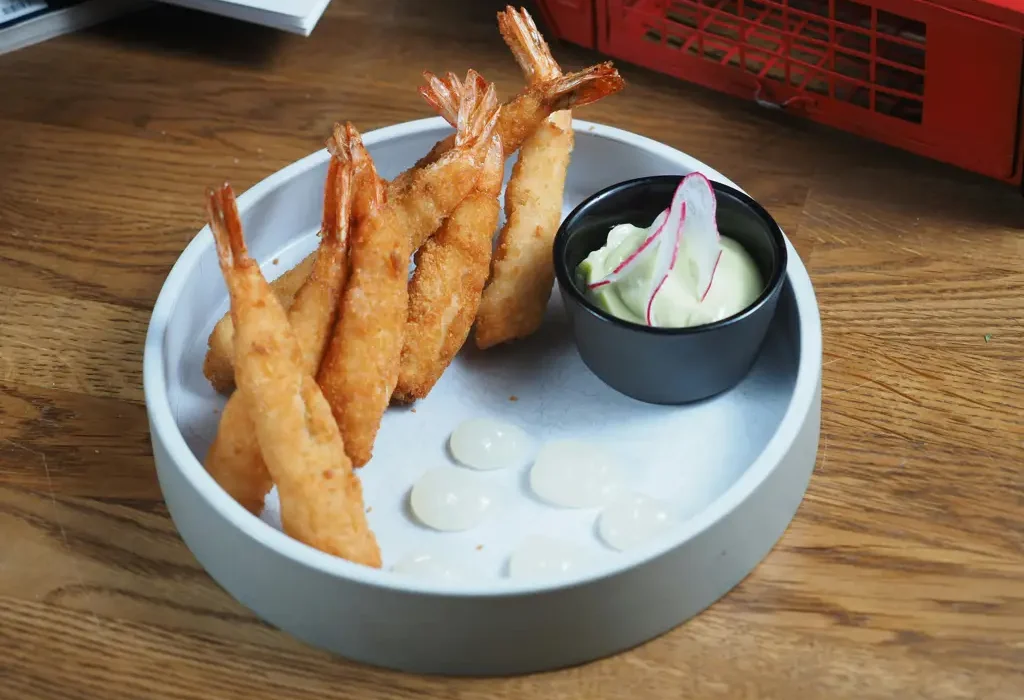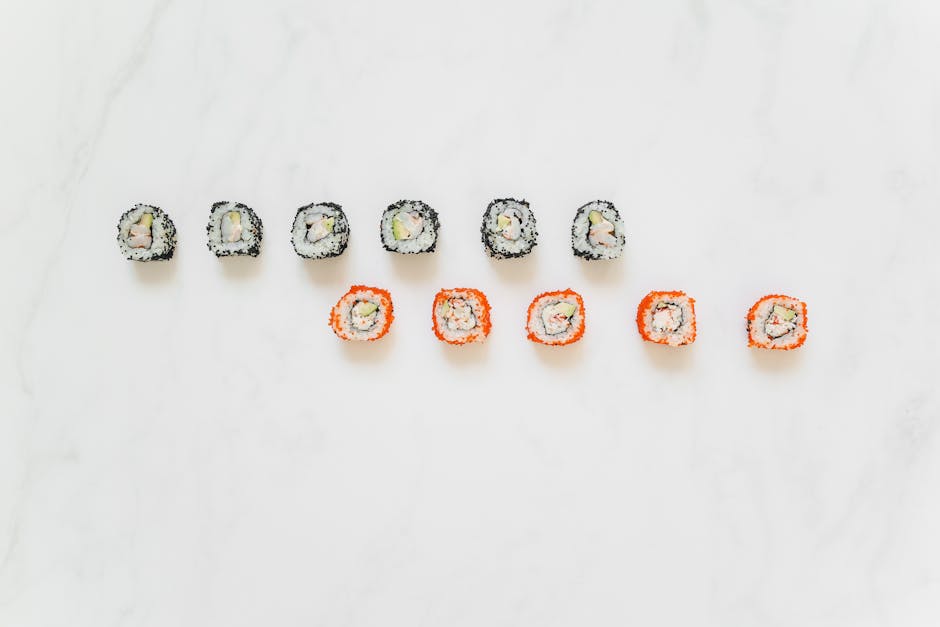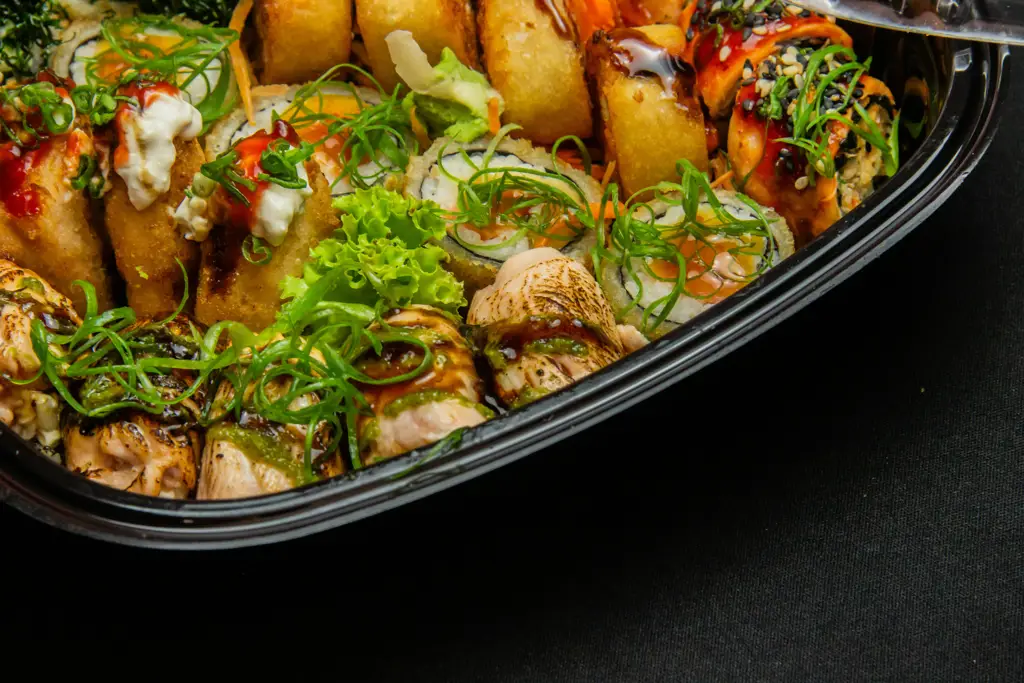Prepare to embark on a culinary journey to Japan with this recipe for Crispy Tempura Shrimp! Tempura, a beloved Japanese culinary technique, boasts a rich and fascinating history, far exceeding its simple appearance. Its origins are believed to be rooted in 16th-century Portuguese traders who introduced deep-frying techniques to Japan. Initially, these methods were used primarily for preparing vegetables, but over time, the Japanese refined and perfected the art of tempura, transforming it into a national treasure.
The evolution of tempura is intrinsically linked to religious practices. During the Edo period (1603-1868), Buddhist monks, observing periods of abstinence from meat, embraced tempura as a delicious and satisfying vegetarian option. This adoption played a crucial role in popularizing the dish across social classes. Interestingly, the light and airy batter, a hallmark of excellent tempura, was initially developed to showcase the natural flavors of seasonal vegetables. The use of seafood, like the succulent shrimp featured in this recipe, became increasingly prevalent, adding another layer of complexity and flavor.
Today, tempura is a ubiquitous presence in Japanese cuisine, enjoyed in upscale restaurants and humble homes alike. It’s estimated that billions of servings of tempura are consumed annually worldwide, a testament to its enduring appeal. Beyond its deliciousness, tempura offers a remarkable textural contrast: the crisp, golden-brown exterior giving way to a delicate, juicy interior. This recipe focuses on perfecting the delicate balance of batter and frying technique, resulting in shrimp that are both incredibly crispy and remarkably tender.
The key to mastering tempura lies in the quality of ingredients and precision of technique. Using ice-cold water and ensuring the batter is not overmixed are crucial steps in achieving that signature lightness and crispness. The art of tempura extends beyond the mere frying process; it’s about respecting the seasonal ingredients and understanding the subtle nuances of flavor and texture. This recipe provides a detailed guide, allowing you to experience the joy of creating authentic, restaurant-quality tempura shrimp in your own kitchen. Get ready to be amazed by the results!
Ingredients and Measurements
This recipe yields approximately 12-15 large tempura shrimp, depending on the size of your shrimp. Accurate measurements are crucial for achieving the perfect crispy tempura batter. Using a kitchen scale for dry ingredients is highly recommended for consistent results.
For the Shrimp:
- 1 pound (450g) large shrimp, peeled and deveined. Choose shrimp that are firm and have a translucent, almost pearly appearance. Avoid shrimp that are mushy or discolored. Pat them completely dry with paper towels before proceeding. This step is crucial for achieving a crispy batter; excess moisture will steam the shrimp instead of crisping them.
- 1/2 teaspoon salt
- 1/4 teaspoon black pepper
For the Tempura Batter:
- 1 cup (120g) all-purpose flour. Do not sift the flour. Sifting can incorporate too much air, leading to a less crispy result. Using a good quality all-purpose flour is essential.
- 1 cup (240ml) ice water. Use very cold or even iced water. The cold temperature helps prevent the gluten in the flour from developing too much, resulting in a lighter and crispier batter. Add the water gradually while whisking, aiming for a consistency similar to heavy cream. It should be slightly lumpy, not completely smooth.
- 1 large egg white (optional). Adding an egg white can enhance the crispiness and create a slightly airier batter. Whisk it separately until soft peaks form before gently folding it into the batter. Be careful not to overmix.
- 1/4 teaspoon baking powder (optional). A tiny pinch of baking powder can further aid in achieving a lighter and crispier batter. Use sparingly, as too much can make the tempura taste slightly bitter.
For Frying:
- Vegetable oil, about 3 cups (710ml). Use a high-smoke-point oil like canola or peanut oil. Fill your deep fryer or a large, heavy-bottomed pot with enough oil to reach a depth of at least 3 inches (7.5cm). This ensures even cooking and prevents the shrimp from sticking to the bottom of the pan.
For Serving (Optional):
- Tempura dipping sauce (recipes readily available online)
- Grated daikon radish
- Shredded cabbage
Important Note: Prepare all ingredients before you begin frying. The tempura batter should be used immediately after mixing to prevent it from becoming too thick. Work quickly and efficiently to ensure the shrimp remains crispy.
Mise en Place (Prep Work)
Proper mise en place is crucial for successful tempura. The speed and efficiency of tempura frying rely heavily on having all your ingredients prepped and readily accessible before you begin. This prevents the batter from becoming gummy and ensures perfectly crisp shrimp.
Shrimp Preparation: Begin by thoroughly cleaning 1 pound (approximately 450g) of large shrimp. Peel and devein them, leaving the tails intact if desired. Pat them completely dry with paper towels. Excess moisture is the enemy of crispy tempura; take the time to ensure they are as dry as possible. You can even go a step further and gently blot them with a clean kitchen towel.
Ice Water Bath: Prepare a large bowl filled with ice water. This is where you’ll briefly submerge the prepared shrimp before battering. The cold water helps to maintain the shrimp’s firmness and prevents it from cooking prematurely in the hot oil. Add about 1/2 cup of ice to the water for optimal temperature.
Batter Preparation: The tempura batter is deceptively simple but requires precision. In a separate bowl, whisk together 1 cup (120g) of all-purpose flour, 1/2 cup (120ml) of ice water, and 1 large egg white. Do not overmix the batter! A few gentle whisks are all it takes to combine the ingredients; a few lumps are perfectly acceptable and contribute to the light and airy texture. Overmixing develops gluten, resulting in a tough batter. Let the batter rest for at least 15 minutes in the refrigerator before use. This allows the gluten to relax, improving the final texture.
Vegetable Oil: Choose a high-smoke-point oil like canola, vegetable, or peanut oil for deep frying. Pour approximately 3 inches (7.5cm) of oil into a heavy-bottomed pot or deep fryer. The oil should ideally reach a temperature of 350°F (175°C). Use a deep-fry thermometer to monitor the temperature accurately. Never overcrowd the pot; frying in batches ensures even cooking and maintains the oil temperature.
Optional Dipping Sauce: While the shrimp is frying, prepare your dipping sauce. A simple combination of equal parts soy sauce and grated daikon radish (about 1/4 cup each) works well. You can add a touch of finely grated ginger for extra flavor. Prepare this sauce ahead of time to allow the flavors to meld. Alternatively, you can make a tentsuyu, a traditional Japanese tempura dipping sauce, which typically involves dashi, soy sauce, mirin, and grated daikon radish.
Garnish: Have your garnishes ready. Finely shredded daikon radish and a lemon wedge are classic garnishes for tempura shrimp. These add a refreshing element to contrast the richness of the fried shrimp. Prepare the garnishes just before serving to maintain their freshness.
With all your ingredients prepped and measured, you’re ready to begin frying. Remember, perfect mise en place is the key to perfectly crispy and delicious tempura shrimp.
Batter Preparation: The Key to Crispy Tempura
The secret to achieving truly exceptional tempura lies in the batter. It’s crucial to understand that tempura batter is unlike any other; it’s delicate, light, and airy, and its preparation demands precision and a gentle hand. Overmixing is the enemy here, leading to a tough, chewy result. We’ll be using a simple yet effective recipe that consistently delivers crispy, golden-brown shrimp.
Ingredients for the Batter:
- 1 cup (120g) all-purpose flour (Do not use self-rising flour)
- 1 cup (240ml) ice water (Use ice water for maximum crispiness. The colder the water, the better)
- 1 large egg white (Room temperature is ideal for easier whipping)
- Pinch of salt (Enhances the flavor of the shrimp)
Instructions:
- Sift the flour: Sift the all-purpose flour into a large bowl. This removes any lumps and ensures a smoother batter. A fine-mesh sieve is ideal for this task.
- Whisk in the salt: Add a pinch of salt to the sifted flour and whisk gently to combine. Avoid over-whisking at this stage.
- Prepare the ice water: Fill a measuring cup with ice cubes and add enough water to reach the 1 cup (240ml) mark. This ensures the water remains as cold as possible throughout the batter preparation.
- Gradually add the ice water: Slowly pour the ice water into the flour mixture while whisking gently with chopsticks or a fork. The goal is to create a batter with a slightly lumpy texture. Avoid vigorous whisking, as this will develop the gluten in the flour and result in a tough batter. The batter should be thin enough to coat the shrimp easily, but not so thin that it runs off.
- Incorporate the egg white: Gently fold in the room temperature egg white. Do not whisk it in vigorously. A few gentle folds are sufficient to incorporate the egg white without creating too much gluten development.
- Let the batter rest: Allow the batter to rest for at least 15 minutes. This allows the gluten to relax, contributing to a lighter and crispier final product. Do not refrigerate the batter, as this will make it too thick and gummy.
- Prepare your frying station: While the batter rests, prepare your frying station. Ensure you have a deep pot or wok filled with enough oil for deep frying. The oil should be heated to 350°F (175°C) before you begin frying the shrimp. A deep-fry thermometer is essential for accurate temperature control.
Professional Tip: The key to a light and crispy tempura batter is to use the minimum amount of water necessary to create a pourable batter. It is better to have a slightly lumpy batter than a smooth one. The lumps will create air pockets in the batter, leading to increased crispiness.
Important Note: Once the batter is prepared, work quickly to coat and fry the shrimp. The longer the batter sits, the more likely it is to become heavy and gummy.
Shrimp Preparation
Proper shrimp preparation is crucial for achieving perfectly crispy tempura. Using fresh, high-quality shrimp will significantly impact the final taste and texture. For this recipe, we’ll be using 1 pound (450g) of large or extra-large shrimp, peeled and deveined. You can purchase pre-peeled and deveined shrimp to save time, but ensure they are fresh and firm to the touch.
Begin by rinsing the shrimp under cold running water to remove any debris. Pat them thoroughly dry with paper towels; excess moisture is the enemy of crispy tempura. This step is vital because any remaining water will cause the batter to steam the shrimp instead of frying it crisply.
Next, we need to prepare the shrimp for battering. If using large shrimp, you may want to cut them in half lengthwise to ensure even cooking and a more delicate texture. Extra-large shrimp can be left whole or cut into thirds depending on preference. Consistency in size is key for uniform cooking. If the shrimp pieces are different sizes, some will be overcooked while others remain undercooked.
Now, let’s address the crucial step of marinating the shrimp. This step isn’t strictly necessary, but it significantly enhances the flavor and tenderness of the final product. In a medium bowl, gently toss the shrimp with 1 tablespoon of sake (or dry sherry as a substitute), 1 teaspoon of soy sauce, and ½ teaspoon of grated ginger. Avoid over-marinating, as this can make the shrimp mushy. A brief 15-20 minute marination is sufficient. If you’re short on time, you can skip this step altogether.
After marinating (or if skipping this step), gently pat the shrimp dry again with paper towels. This removes any excess marinade that could interfere with the batter adhering properly. Thorough drying is paramount for a light and crispy crust. Any remaining moisture will create steam during frying, resulting in a soggy tempura.
Finally, before dredging the shrimp in the tempura batter, it’s helpful to lightly dust them with a small amount of cornstarch or potato starch. This extra step helps the batter adhere to the shrimp even better and contributes to an extra-crisp finish. Use a light hand to avoid creating a thick layer. A thin dusting is all that’s required.
With your shrimp properly prepared, you are now ready to proceed to the next step: making the tempura batter and frying your delicious shrimp. Remember, patience and attention to detail during the preparation phase will significantly improve the final outcome of your crispy tempura shrimp.
Frying Technique: Achieving Perfectly Crispy Tempura Shrimp
Frying tempura is an art form that requires precision and a light touch. The goal is to achieve a feather-light, incredibly crispy crust while keeping the shrimp succulent and juicy inside. This requires careful attention to oil temperature, batter consistency, and frying technique. We’ll break down the process step-by-step to ensure your tempura shrimp are restaurant-quality.
Oil Temperature is Crucial: The ideal oil temperature for frying tempura is between 350°F (175°C) and 375°F (190°C). Using a deep-fry thermometer is essential for accurate temperature control. Too low a temperature results in greasy, soggy tempura, while too high a temperature will burn the batter before the shrimp is cooked through. Maintain a consistent temperature throughout the frying process by adjusting the heat as needed. A large pot or wok, filled about halfway with oil, will help maintain a stable temperature.
Batter Preparation and Application: Ensure your tempura batter is properly prepared according to the recipe instructions – it should be light and slightly lumpy, not smooth. Avoid overmixing the batter, as this develops gluten and results in a tough crust. Gently dip each shrimp into the batter, allowing excess batter to drip off. Don’t overcrowd the shrimp with batter; a thin, even coating is key.
Frying Process: Carefully slide the battered shrimp into the hot oil, ensuring not to overcrowd the pot. Overcrowding will lower the oil temperature, leading to soggy tempura. Fry in batches of 4-6 shrimp at a time, depending on the size of your pot. Avoid disturbing the shrimp while frying; this can cause the batter to break apart. Fry for approximately 2-3 minutes, or until the batter is golden brown and crispy. You should see the shrimp float to the surface as they cook.
Draining and Serving: Once golden brown and crispy, carefully remove the shrimp from the oil using a slotted spoon or spider. Place them on a wire rack or plate lined with paper towels to drain excess oil. Immediate draining is crucial to prevent the tempura from becoming soggy. Serve immediately while the tempura is hot and crispy. Any delay will result in a loss of crispness.
Professional Recommendations:
- Use a neutral-flavored oil with a high smoke point, such as canola or vegetable oil.
- Prepare all your ingredients (shrimp, batter, dipping sauce) before you start frying to maintain efficiency and consistent oil temperature.
- Don’t reuse the oil after frying. The oil will break down and impart off-flavors to subsequent batches.
- Practice makes perfect! Don’t be discouraged if your first attempt isn’t perfect. With a little practice, you’ll master the art of frying crispy tempura shrimp.
By following these techniques and paying close attention to detail, you will be well on your way to creating perfectly crispy and delicious tempura shrimp that rival any restaurant.
Draining and Resting
Proper draining and resting of the tempura shrimp is crucial for achieving that signature light and crispy texture. Neglecting this step can lead to soggy, oily shrimp that lack the desired airy lightness. This section details the process to ensure your tempura shrimp are perfectly prepared.
Once you’ve carefully and gently lowered your battered shrimp into the hot oil, resist the urge to overcrowd the fryer. Overcrowding will lower the oil temperature, resulting in greasy, undercooked shrimp. Work in batches, frying approximately 4-6 large shrimp at a time, depending on the size of your frying pan. This allows for even cooking and maintains the optimal oil temperature.
After 2-3 minutes of frying (or until golden brown and cooked through – the internal temperature should reach 165°F (74°C)), use a slotted spoon or spider to carefully remove the shrimp from the hot oil. Avoid using a solid spoon, as this will trap excess oil. The slotted utensil allows the oil to drain away immediately.
Transfer the fried shrimp to a wire rack placed over a baking sheet lined with paper towels. The wire rack is essential; it allows for maximum air circulation, preventing the shrimp from becoming soggy from trapped steam. Paper towels absorb any excess oil clinging to the shrimp, further enhancing crispiness.
Let the shrimp rest on the wire rack for at least 2-3 minutes. This resting period is vital. During this time, the internal temperature will continue to rise slightly, ensuring the shrimp are fully cooked. More importantly, it allows the batter to solidify and the excess oil to drain completely. This step is often overlooked, but it significantly impacts the final texture and quality of your tempura.
If you find that your shrimp are still slightly oily after draining, you can gently blot them with additional paper towels. However, avoid pressing down hard, as this can crush the delicate batter and compromise the crispness. A light, gentle blot is all that’s needed.
For extra crispy tempura, consider a second, very brief (15-30 seconds) frying session after the initial rest. This second frying helps to further crisp the batter, creating an exceptionally crunchy exterior. Be cautious not to over-fry, as this can lead to burning. This step is optional, but highly recommended for achieving ultimate crispiness.
Once the shrimp have rested and are completely cool to the touch, they are ready to be served. Remember to enjoy them immediately for the best possible texture and taste. Do not store them for later, as the crispness will degrade quickly. Serve your delectable crispy tempura shrimp alongside your favorite dipping sauce and garnishes.
Recommendations for Crispy Tempura Shrimp
To achieve the crispiest tempura shrimp, ensure your ingredients are ice-cold. This helps prevent the batter from becoming gummy. Dry the shrimp thoroughly before dipping them in the batter. Don’t overcrowd the fryer; work in batches to maintain the oil’s temperature for optimal crispiness. Overcrowding will lower the oil temperature and result in soggy shrimp.
For best results, use a high-smoke-point oil like canola or vegetable oil. Maintaining the correct oil temperature (around 350°F or 175°C) is crucial. Use a thermometer to monitor the temperature and adjust the heat as needed. If the oil is too cool, the shrimp will absorb too much oil and become greasy. If it’s too hot, the batter will brown too quickly before the shrimp is cooked through.
Serving Suggestions: These crispy tempura shrimp are delicious on their own as a snack or appetizer. However, they pair beautifully with a variety of dipping sauces. A classic choice is a simple tempura dipping sauce made with soy sauce, rice vinegar, mirin, and grated ginger. Other options include a spicy mayonnaise, sweet chili sauce, or even a creamy wasabi aioli. Serve them immediately after frying for the best texture and flavor.
Complementary Dishes: Tempura shrimp are incredibly versatile and can be incorporated into various dishes. They make a fantastic addition to ramen bowls, adding a delightful crunch to the broth and noodles. They are also a wonderful topping for salads, offering a protein boost and textural contrast. Consider serving them with a side of steamed rice, Japanese-style pickled vegetables (tsukemono), or a refreshing seaweed salad for a complete and balanced meal.
Storage: For optimal freshness, consume tempura shrimp immediately after frying. However, if you have leftovers, store them in an airtight container in the refrigerator. Reheat them gently in a low oven or air fryer to avoid making them soggy. They are best enjoyed within 1-2 days of frying. Freezing is not recommended as it significantly alters the texture.
Nutritional Information (per serving, approximate): The nutritional content of tempura shrimp varies depending on the size of the shrimp and the amount of batter used. However, a typical serving (about 3-4 large shrimp) might contain approximately 250-350 calories, 15-25 grams of protein, 10-20 grams of fat, and 10-15 grams of carbohydrates. Note: This is an estimate, and the actual nutritional values may vary. For a more precise calculation, use a nutrition tracking app and input the specific ingredients and quantities used in your recipe.
Important Note: Always ensure the oil is properly heated before frying to prevent accidents. Never leave the oil unattended while frying. Use caution when handling hot oil. Adjust the recipe according to your dietary needs and preferences. Enjoy your delicious and crispy tempura shrimp!





